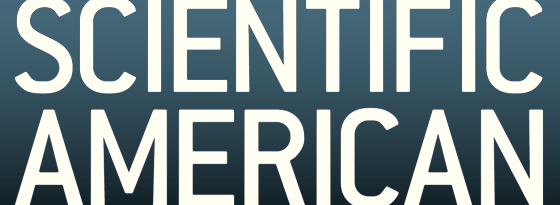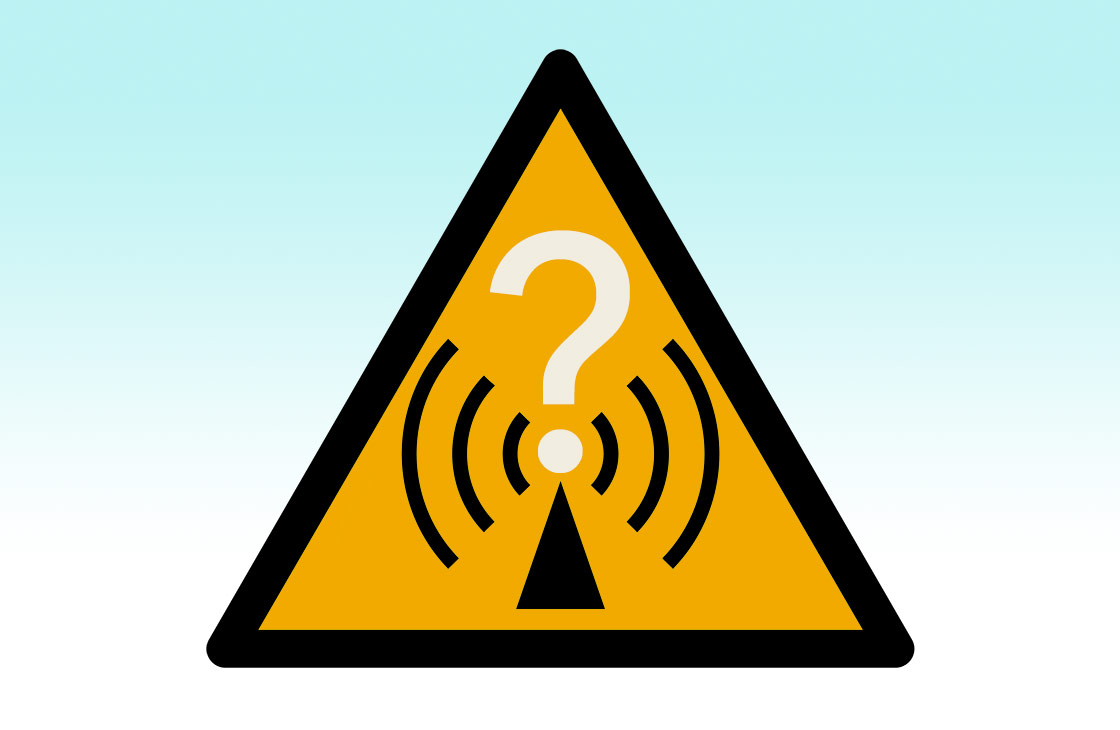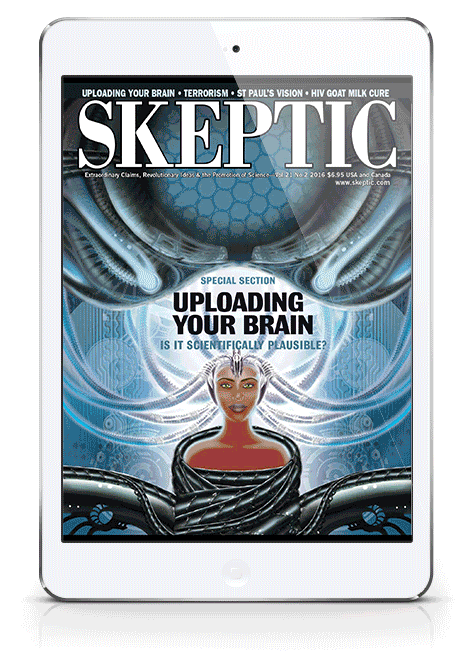In this week’s eSkeptic:
SKEPTIC MAGAZINE 21.2
Uploading Your Brain
Is virtual immortality possible? The latest issue of Skeptic magazine (21.2), UPLOADING YOUR BRAIN, examines the scientific plausibility of preserving the mind indefinitely. This issue also contains a special section on extremism, and articles on: the discovery of Homo naledi, Charlie Sheen’s HIV Goat Milk Doctor, the decline of Intelligent Design, how the anti-anti-science movement has gone too far, and more!
Get the digital edition instantly from PocketMags.com, or via the Skeptic Magazine App for iOS, Android, BlackBerry PlayBook, Kindle Fire HD, Mac, PC, and Windows 8 devices. You can also pre-order the print edition from Shop Skeptic. The print edition won’t likely hit newsstands for another week or two.
30-DAY FREE TRIAL
on digital subscriptions
Subscribe to Skeptic magazine on PocketMags.com or via the Skeptic Magazine App on your favourite iOS or Android device (or via PocketMags.com on your PC or Mac) and try the latest issue free for 30 days! Here’s a sneak peak at this issue for iPad…
JUNIOR SKEPTIC
Man-Eating Plants (issue 59)
Physically bound inside each and every issue of Skeptic magazine is Junior Skeptic: an engagingly illustrated science and critical thinking publication for younger readers (and the young at heart).
In this issue we journey into jungles, push past tangled vines, and search for something sinister: trees that are said to eat human beings! According to travellers’ tales and newspaper stories, some mysterious plants capture and consume large animals. Growing in remote regions, these bloodthirsty vegetables wait for the unwary, surrounded by the bones of their victims. Their branches stir when there is no breeze. Inviting foliage conceals thorny vines ready to seize struggling prey. Is there any truth to these tales? Could such plants truly exist? Let’s find out!

SCIENTIFIC AMERICAN “SKEPTIC” COLUMN FOR JUNE 2016
Death Wish: What Would be Your Final Words?

Between December 7, 1982, and February 16, 2016, the state of Texas executed 534 inmates, 417 of whom issued a last statement. This January in the journal Frontiers in Psychology, psychologists Sarah Hirschmüller and Boris Egloff, both at Johannes Gutenberg University Mainz in Germany, published the results of their evaluation of most of the statements, which they put through a computerized text-analysis program called the Linguistic Inquiry and Word Count. The biggest finding was a statistically significant difference between the average percentage of positive emotion words (9.64) and negative ones (2.65). Is that a lot?
To find out, the psychologists compared this dataset with a broad spectrum of written sources, including scientific articles, novels, blogs and diaries, consisting of more than 168 million words composed by 23,173 people. The mean of 2.74 percent positive emotion words for each entry was statistically significantly lower than that of the prisoners. In fact, these death-row inmates were more positive than students asked to contemplate their own death and write down their thoughts and even more positive than people who attempted or completed suicides and left notes. What does this mean?
Hirschmüller and Egloff contend that their data support terror management theory (TMT), which asserts that the realization of our mortality leads to unconscious terror, and “an increased use of positive emotion words serves as a way to protect and defend against mortality salience of one’s own contemplated death.” But if that were so, then why the difference between the inmates’ statements and those of suicide attempters and completers? Surely those about to kill themselves would be equally terrorized by the prospect of their imminent self-demise […]
FOLLOW MICHAEL SHERMER ON
Twitter • Facebook • Insight • The Moral Arc Blog

There is no known biological mechanism for non-ionizing electromagnetic fields (EMF) to cause DNA damage, and thus cancer. Yet, the media continue to drop panic bombs, instilling fear where none is warranted. In this week’s eSkeptic, Dr. Julie Frantsve-Hawley reminds us of the importance of sound science communication so that the general public can experience the same comfort in and reliance on science as scientists themselves. Dr. Hawley received her Ph.D. in Biomedical Sciences from Harvard University. Read the author’s bio at the end of the article.
Electromagnetic Fields and Parental Panics: A case study in how science can bring comfort
by Julie Frantsve-Hawley
I am a scientist in the field of evidence-based medicine and public health. Basically, I am a science translator and communicator. I help healthcare workers use current science when treating patients, and developing policies and programs. Much of what I do involves working with world experts on a wide variety of topics to determine answers to health-related science issues. We ask questions about effectiveness of medical treatments. Which treatment is better? What treatments might cause harms? What are the risk factors for disease? We analyze results of clinical studies to figure out exactly what the results mean, and what we should do with this information.
In addition to my career, I live the typical life of a working mother. I have two kids (a girl and a boy), a three-bedroom house in the suburbs, a two-car garage, a cat, a dog, two fish, and an amazing husband. Rarely does my profession and personal life interact, but a few years ago on my daughter’s first day of school in first grade my worlds collided. One day while the children were having fun on the playground after school, one of the other mothers threw me what I call a panic science bomb. It seems that her daughter has eye twitches, and she has concluded that they are caused by electromagnetic fields (EMF) emanating from a transformer outside of her daughter’s classroom. The transformer also happens to be in front of my daughter’s new classroom, so that got my attention. Oh, and EMF causes cancer in children, she continued, suggesting that our daughters’ lives are at stake!
I call this a panic bomb because, although I am a scientist, I knew little about the health effects of EMFs, so for a moment I began to panic! What exactly are EMFs? And what might they be doing to my daughter and the other children at the school? My heart started racing. This is, of course, a natural reaction, for as Dr. Daniel Kahneman describes in his book Thinking Fast and Slow,1 people tend to react first with rapid intuition and emotion. But after a few moments my more thoughtful and critical thinking kicked in. I asked the mother what her daughter’s pediatrician or eye doctor had said about the eye twitches. Her response was completely unexpected. She had not taken her daughter to either a pediatrician or eye doctor. Presumably her medical information came from the Interweb. She said she has a very high standard of health for her family and was demanding that the school move the transformer. […]

The Invention of Science
SKEPTICALITY EPISODE 272
In this episode of Skepticality, Derek spends some time with Professor of History David Wootton to talk about his latest book The Invention of Science: A New History of the Scientific Revolution, a book about the early years in which modern methods of inquiry and scientific thinking came to be. Find out how a teacher who once focused on historical topics like politics and atheism ended up writing books about science and medicine.

Get the Skepticality App — the Official Podcast App of Skeptic Magazine — so you can enjoy your science fix and engaging interviews on the go! Available for iOS, Android, and Windows.














